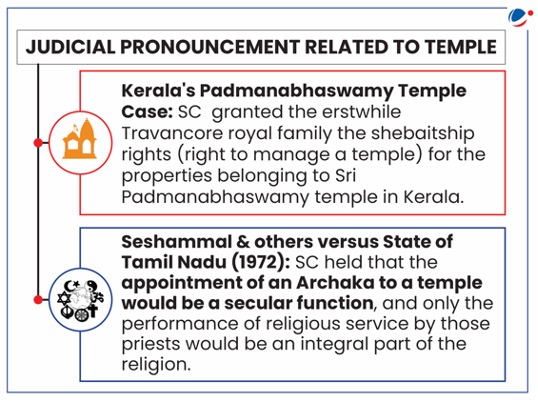Why in the news?
Karnataka Legislative Assembly passed the Karnataka Hindu Religious Institutions and Charitable Endowments (Amendment) Bill, 2024 to regulate temples in the state.
More on the news
- The new bill amends the Karnataka Hindu Religious Institutions and Charitable Endowments Act, of 1997.
- The Bill mandates that the government will collect 10% and 5% of the income from temples that have annual revenue of more than ₹1 crore and ₹10 lakh respectively.
- Previously, temples earning between ₹5 lakh and ₹10 lakh annually contributed 5% of their net income to the Common Pool Fund, while those earning above ₹10 lakh allocated 10%.
- Bill proposed to utilise the money for the welfare of archakas (priests) and the development of temples whose annual income is less than ₹5 lakh.
Legal and Institutional Framework to Regulate Temples
- Article 25 (1) gives the freedom of religion and 25 (2) talks about areas where the State may intervene and make laws or regulate religious institutions.
- Article 26 provides for the freedom to manage the religious affairs of the citizens and is subject to public order, morality and health.
- Entry 28 of List III of Schedule VII empowers both Union and State Legislatures to make law on “Charities and charitable institutions, charitable and religious endowments and religious institutions”.
- Hindu Religious and Charitable Endowments (HR&CE): Several states across the country have enacted legislative and regulatory frameworks to regulate these institutions through the powers accorded by the Constitution.
- Hindu Religious Endowments Commission (1960): The Commission declared that government control over temples was essential to prevent maladministration.
Temple regulation in the Colonial Period
|
State control of Temple: Argument for and against
Arguments in favour | Arguments in against |
|
|

Way Forward
- Separation of religious and administrative domain: There should be a clear separation of power in operations relating to the religious domain and the administrative (secular) domain.
- Inter Temples Network Structure: Temples can be grouped in three categories based on their size. Then club temples based on the hub and spoke model in which larger and administratively strong temples support smaller temples in the region.
- Good governance principles: State-level Temple Administration Board (Having state officials) assisted by the Temple Management Committee (TMC) and Temple Level Trusts (having priests, locals etc.) can be constituted to administer different functions.
- Hindu Religious and Charitable Endowment Act, 1991 also provides for a Temples Administration Board.
- Special Purpose Vehicle (SPV): Temple Development and Promotion Corporation (TDPC) can be formed to undertake all development work of all temples relating to tourism, networking of temples, promoting research and publication, IT, training, and capacity building, etc.
- Following Best Practices: The concept of Devaswom (property of God) in Kerala is an interesting model to keep check on corruption.




